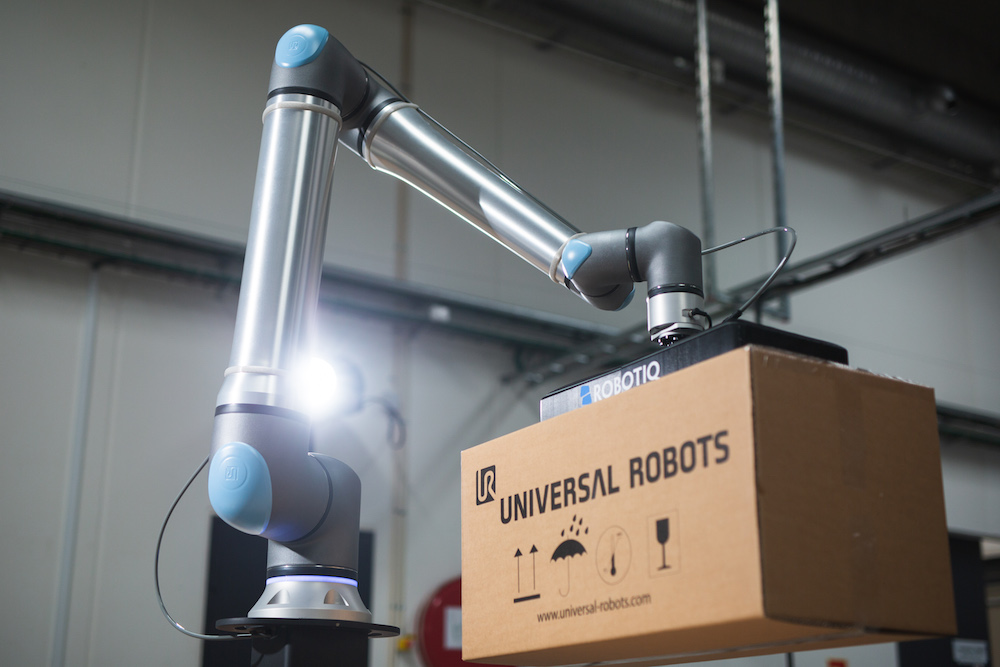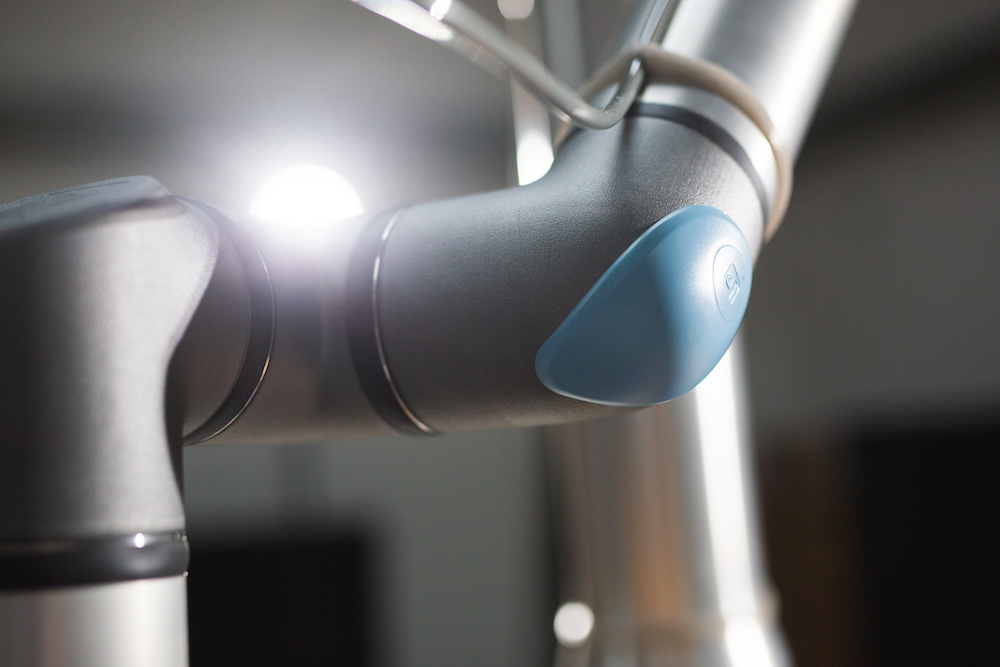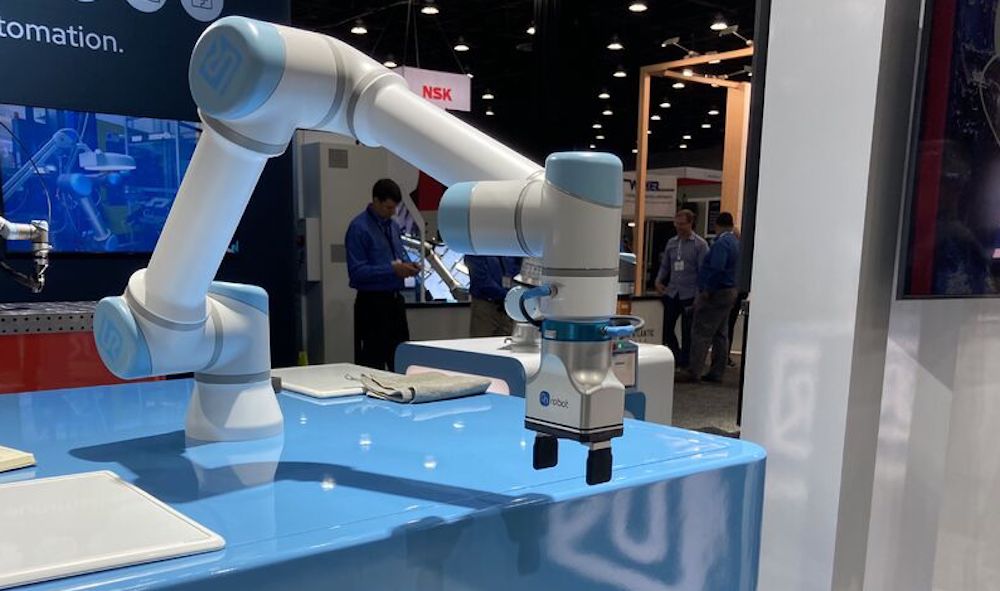|
Listen to this article  |

UR20 has a 20 kg payload, 1750 mm reach, and 30% more speed and torque when compared to other UR cobots. | Universal Robots
Universal Robots (UR) this morning at Automatica finally unveiled what it’s been teasing the last couple of months. It introduced the UR20, the Danish company’s fastest and strongest collaborative robot arm ever. The UR20 is expected to be available for pre-order in late Q4 2022 and will begin shipping in Q2 2023 for an undisclosed price.
The UR20, which has been redesigned from the ground up, is the first model in a new series of next-generation cobots that will complement the e-Series. The UR20 features a 20 kg payload, 1750 mm reach, ± 0.05 mm repeatability and up to 30% more speed and torque when compared to other UR cobots. According to the company, the UR20 is well suited for applications such as machine loading, machine tending, materials handling, palletizing and welding. Here is the datasheet for the UR20 cobot (PDF). You can read the FAQs for the UR20 here (PDF).
UR told The Robot Report additional new cobots will be introduced in late 2023 or early 2024. The last time UR introduced a new cobot was 2019 when it added the UR16e. It offers a 16 kg payload and is designed for heavy-duty applications. UR’s cobot portfolio also includes the UR3e (3 kg payload), UR5e (5 kg) and UR10e (12.5 kg).
At Automatica in Munich, Germany, the UR20’s palletizing capabilities are being demonstrated with UR+ partner Robotiq. The new extended reach is demonstrated stacking to the height of 1800mm, covering two standard European (40in x 48in / 1200mm x 800mm)) pallets. The demo shows how the kinematics can cover both the pallets and an infeed at the same time.
New joint design drives UR20’s performance
UR president Kim Povlsen said a new joint design is the key to the increased speed and torque. “We needed a new mechanical joint design to have more torque. We’ve been working on this for a while, and it’s hard to do. But it won’t take long for people to take apart the joint and see that it’s completely different inside.”
On the UR20, the base and shoulder have a maximum speed of 120˚/s, while the elbow can move up to 150˚/s. The three wrist joints can move up to ± 210˚/s. On the UR16e cobot, for comparison, the base and shoulder offer a maximum speed of ± 120°/s, while the elbow and three wrist joints each have a top speed of ± 180°/s.

A close-up of the new joint on the UR20 cobot. | Credit: Universal Robots
“Innovation had to happen across the board,” Povlsen said. “Joints and gears aren’t our core competency. We collaborated with vendors on different parts in the joints to iterate our way here. We needed more reach, more payload, and more speed. We have smart engineers who cracked the code to still make sure it’s a safe cobot to be around.”
All of UR’s cobots are power and force limited (PFL) robots. Just like the e-Series, the UR20 will be certified to both EN ISO 13849-1, Cat. 3 PLd and ISO 10218-1 by TÜV Nord. UR also said that like the e-Series, the UR20 has 17 customizable safety functions so far, including having stopping time limiting and stopping distance limiting.
The UR20’s base offers the traditional flange design that gets bolted down. But in a change of appearance for UR, none of the joints have external screws. So it could be easier for UR to do a scrubbable version of this cobot than with the current e-Series.
Povlsen told The Robot Report the entire control software has been rethought on the UR20; although it is compatible with the latest version of PolyScope. Some of the major improvements, Povlsen said, include how to develop UR caps and have multiple UR caps working together at the same time.
“Anything we can do to simplify the path for customers to be more innovative, that’s something we’re investing in.”
Why the UR20?
UR certainly is not the first company to offer a 20 kg cobot. There are at least several others, including Fanuc and Yaskawa. Povlsen said UR learned from its customers that there was a gap in its product portfolio.
“There were a number of applications that our portfolio didn’t cover [before the UR20],” said Povlsen. “But specifically packaging and palletizing. Moving 40-lb boxes onto a pallet over and over again, day after day, is a task that you should not be doing. We had lots of conversations with customers about how we can help them deal with these challenges.”
UR was acquired by Teradyne for $285 million in 2015. Teradyne president Greg Smith, who runs the company’s industrial automation group, said UR’s cobot sales have been trending towards heavier payloads. “Over the last three years, the UR10e and above have accounted for about half of our unit volume,” he said. “So it made sense to augment the product line at the high end.”
Smith said the primary purpose of cobots is to help manufacturers solve labor shortages. “They have trouble hiring people. If you look at what people can practically lift, it’s 15-20 kilograms,” he said. “So we had a gap above 16 kg in tasks that people want to do, in particular machine tending and palletizing.”
What’s next after the UR20?
UR is facing increasing competition with each passing year. But the company is also performing better than ever. After increasing sales 41% in 2021 to $311 million, UR generated $85 million in Q1 2022, kicking off the year by setting a quarterly record. Smith hinted at what could be next, and it sounds like upgrading the e-Series models with the new joint design.
“Now that we have the next-generation joint, one can imagine we’d put it to work to deliver a better product for our customers,” Smith said. “In terms of higher payloads, I wouldn’t put it out of the realm of possibility, but we’re almost outside of what a person can lift. Once you build something significantly more powerful than a person, you’re not solving the labor scarcity problem, now you’re competing with traditional industrial robots.”

UR’s “concept cobot” at Automate 2022 in Detroit. | Credit: Steve Crowe, The Robot Report
UR also showcased a “concept cobot” at Automate 2022 in Detroit. Right away I noticed the white casing, not the silver. It’s a different material and finish. The cobot is also completely enclosed, so it can be used in certain food applications (and others) that UR hasn’t played in. This “concept cobot” wasn’t a product, but it could be one day – or perhaps certain aspects of it could be incorporated into UR cobots.
Smith said UR is evaluating releasing a cobot that can be used in food and pharmaceutical applications. “Our intent is to move pretty quickly in this space,” he said.
There has long been talk about the blurring of the lines between cobots and traditional industrial robot arms. That talk has increased a bit with the introduction of robots arms that can operate in dual modes – industrial or collaborative. UR seems dedicated to its approach.
“We are staying in the cobot lane,” Povlsen said. “We dare to say what a cobot is – we invented it.”
Credit: Source link


Comments are closed.